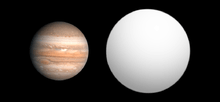WASP-15b
WASP-15b is an extrasolar planet discovered in 2008 by the SuperWASP collaboration, which seeks to discover exoplanets that transit their host stars. The planet orbits its host star at a distance of 0.05 AU every four days. The mass of this planet is about one half that of Jupiter, but its radius is nearly 50% larger than Jupiter's, making the density of this planet only one quarter that of water; it is thought that some other form of heating must explain its extremely low density.[1] WASP-15b's discovery was published on April 29, 2009.
 Size comparison of WASP-15b with Jupiter. | |
| Discovery | |
|---|---|
| Discovered by | West et al. (SuperWASP)[1] |
| Discovery site | SAAO[1] |
| Discovery date | April 29, 2009 (Publication date)[1] |
| Transit[1] | |
| Orbital characteristics | |
| 0.0499 ± 0.0018 AU (7,460,000 ± 270,000 km)[2] | |
| Eccentricity | 0[2] |
| 3.7520656 ± 2.8e-06[2] d | |
| Inclination | 85.5 ± 0.5[2] |
| Star | WASP-15 |
| Physical characteristics | |
Mean radius | 1.428 ± 0.077[2] RJ |
| Mass | 0.542 ± 0.05[2] MJ |
Mean density | 0.247 ± 0.035 g/cm3 (0.0089 ± 0.0013 lb/cu in)[1] |
| Temperature | 1652 ± 28[1] |
Discovery
WASP-15 was first observed by the WASP-South branch of the SuperWASP project, which operates from the South African Astronomical Observatory, between May 4, 2006 and July 17, 2006. It was later observed by WASP-South from January 31, 2007 to July 17, 2007 and from January 31, 2008 to May 29, 2008.[1] Further analysis taken from 24,943 collected data points revealed eleven full or partial transits.[1]
Follow-up observations were conducted by a European and American science team at the 1.2 m Leonhard Euler Telescope at La Silla Observatory in Chile, which further raised the possibility of the existence of a planet in WASP-15's orbit; use of the CORALIE spectrograph on the Euler Telescope between March 6, 2008 and July 17, 2008 revealed that the variations in radial velocity measurements were not because of an eclipsing binary star system.[1]
CORALIE and the High Resolution Echelle Spectrometer (HIRES) revealed the spectrum of WASP-15, which was used to derive the star's characteristics.[1] The science team studying WASP-15 found that, after running best-fit models, WASP-15's radial velocity and transit shifts were most likely due to the existence of a planet.[1]
WASP-15's planet, WASP-15b, had one of the lowest densities known amongst extrasolar planets when it was discovered. Its discovery paper was published by the American Astronomical Society on April 29, 2009 in the Astronomical Journal.[1]
Host star
WASP-15 is an F-type star located in the Hydra constellation. It is located approximately 290 parsecs (900 light years) from Earth and has an apparent magnitude of 10.9, making it invisible to the unaided eye. The star is 1.18 times more massive than the Sun, and has a radius that is 1.477 times larger than that of the Sun, making it more diffuse. WASP-15 has an effective temperature of 6300 K, and is thus hotter than the Sun, although at 3.9 billion years, it is also younger. WASP-15 has a metallicity of [Fe/H] of -0.17, which means that it has 68% of the iron found in the Sun.[2]
Characteristics
WASP-15b has a mass of 0.542 times Jupiter's mass and a radius that is 1.428 times Jupiter's radius. Due in part to its proximity to its host star, a distance of 0.0499 AU (7,500,000 km), WASP-15b is greatly inflated, with a density of 0.247 g/cm3. Another factor, such as an internal heat source, is suspected to add to this extremely high radius and extremely low density.[1] WASP-15b orbits its host star every 3.7520656 days. It also has an orbital inclination of 85.5º, making it almost edge-on as seen from the Earth's perspective.[2]
Naming
In 2019 the IAU announced that WASP-15 and its planet WASP-15b would be given official names chosen by school children from The Ivory Coast. [3][4]
See also
References
- West, R. G.; et al. (2009). "The Low Density Transiting Exoplanet WASP-15b". The Astronomical Journal. 137 (6): 4834–4836. arXiv:0902.2651. Bibcode:2009AJ....137.4834W. doi:10.1088/0004-6256/137/6/4834.
- Jean Schneider (2010). "Notes for star WASP-15". Extrasolar Planets Encyclopaedia. Archived from the original on 2 December 2010. Retrieved 13 May 2011.
- "NameExoWorlds". 2019. Retrieved 6 September 2019.
- "Naming". 2019. Retrieved 6 September 2019.